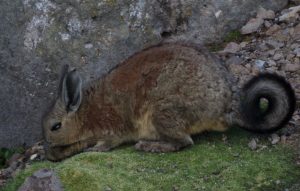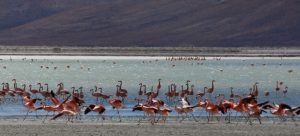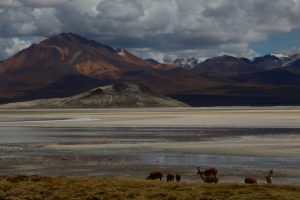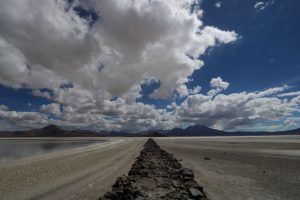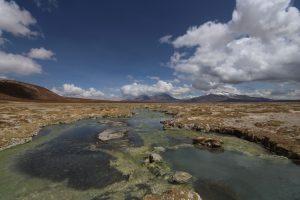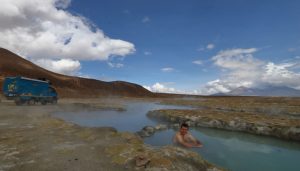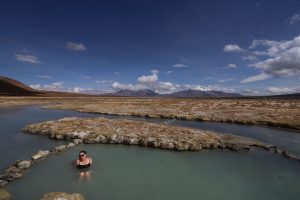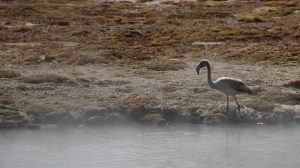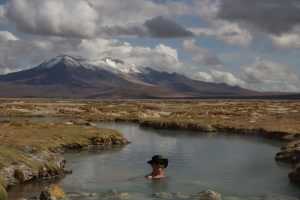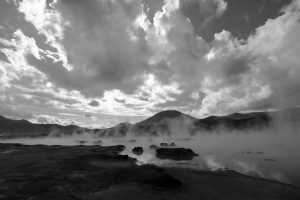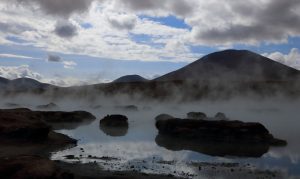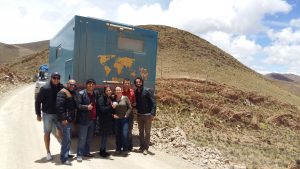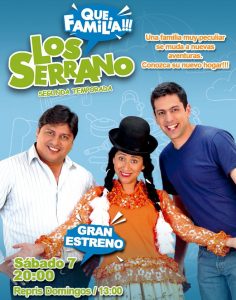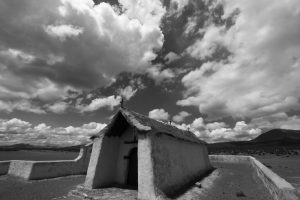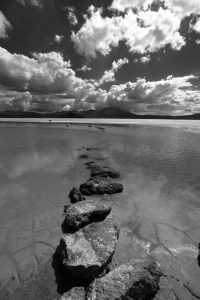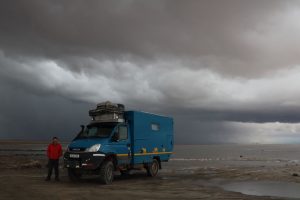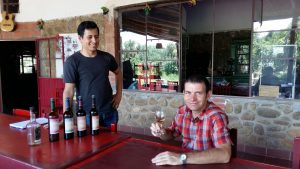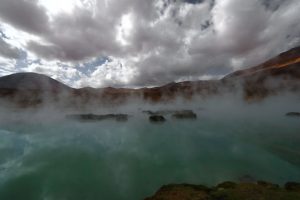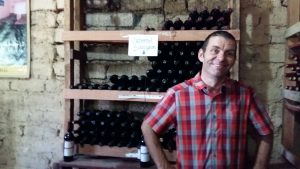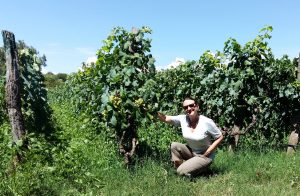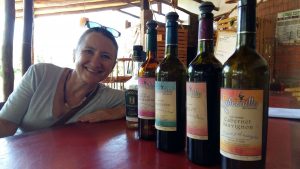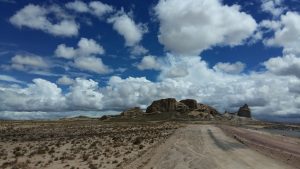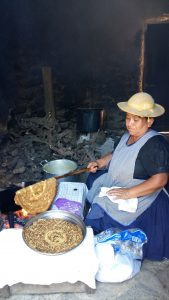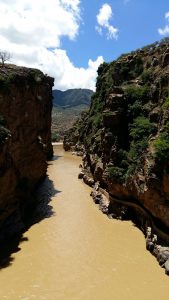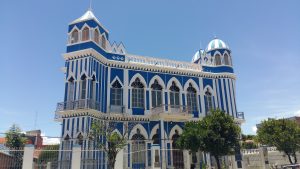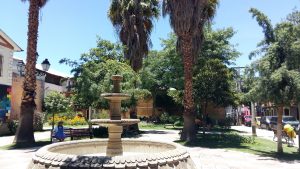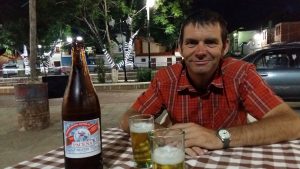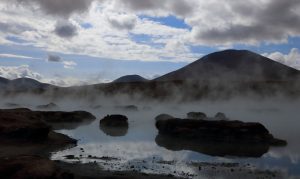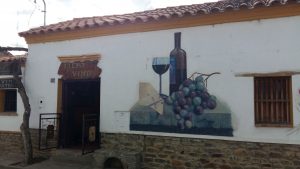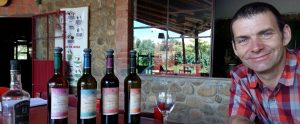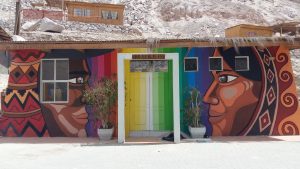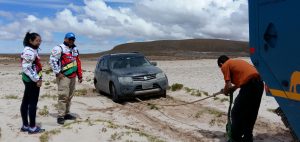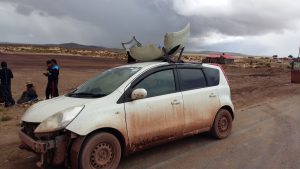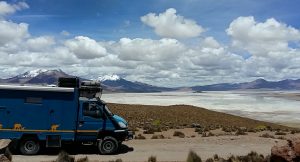In the Andes at over 4,000m again… a bit of re-acclimatisation is required. We interrupted the sequence of our blogs slightly for our ‘Dakar Special’ when we had a tougher than expected challenge to catch the Rally in Bolivia. So now please humour our ‘time-warp’ as we step back in time to a few days before the Dakar: we’re leaving the beaches of Arica on New Year’s Day for a last bit of exploring in the Andes of northern Chile before crossing into Bolivia.

High ground
To reach the Pisiga border crossing we take an indirect but very scenic route through the Andes climbing to over 4,500 m (14,700 ft). It’s rough and steep but we find stunning volcanos, bathing in natural steaming-hot springs and great wildlife including flamingos, vicuñas, llamas, vizcachas! Pictures tell the story better than words:
We love it up here. The landscape and remoteness is stunning; you can see not a soul for days. We would spend far longer up in these parts, except we rarely get a good night’s kip at very high altitude. After a few nights we’re shattered and descend down to the Bolivian altiplano at a mere 3,700 m to get some undisturbed shut-eye!
Back to the Salt
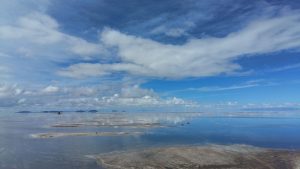
Uyuni Salt Pan – January-style
The border crossing was busy and slow but uneventful, then we spent our first week in Bolivia chasing the Dakar Rally. It wasn’t as easy as we had anticipated, but we had eventual success seeing the start the Stage 9 race-sector (here’s our full Dakar Rally tale of woe). As the Rally headed south out of Uyuni on it’s way to Argentina we decided to hang around the Uyuni area a bit before moving on our way across Bolivia towards Paraguay.
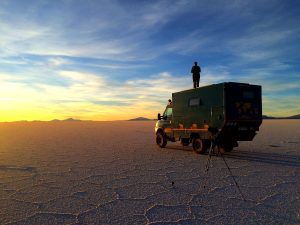
Uyuni Salt Pan – July-style
Long-term followers of the Cuthbert blog may recall that we have been to Uyuni before, on our trip to Bolivia in July last year. In the then winter dry season, we took Cuthbert out onto the spectacular, world’s largest salt pans ‘Salar de Uyuni’ (Altiplano and Whiteness) which was certainly one of the highlights of our whole South America trip so far: an extraordinary experience blasting around randomly on the seemingly endless white salt crust. Thing is… it’s no longer the dry season. The vast dry salt crust is now a vast wet salt lake! The water is mostly only a few inches deep, but it is of course, very salty water. Several locals and tour companies are venturing out into the water in their 4x4s, but we decide that a saline belly-scrub is not conducive to Cuthbert’s long-term preservation and we park-up by the shore.
One of the great attractions of the Salar at this time of year is the potential for beautiful photos of reflections from the sky in the vast, shallow salt-puddle. Critical environmental factors for this opportunity are: (a) wind-free conditions (for that crystal-clear mirror surface on the Salar) and (b) bright blue, sunny skies dotted with fluffy clouds (for that picture-postcard reflective definition on the surface). The conditions aren’t quite perfect for us on this visit, nevertheless the Salar is always one of the world’s most outstanding beauty-spots and we feel priviledged to have seen it in both of its famous states.
Stranded celebrities
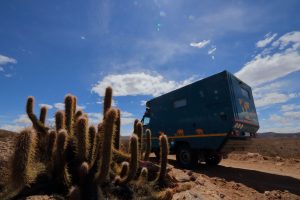 From Uyuni we have to head south to Tupiza before taking the long road east, across the far south of Bolivia. The south-bound road is one of the few main routes in Bolivia yet to be surfaced and it has had a lot of rain over the last few days. The un-bridged rivers are swollen and we have to negotiate several water-crossings. Even by Cuthbert’s relatively hardy standards it’s rough going, but several local 4x4s plough the route daily so it is passable with the right vehicle. Even the occasional bus attempts the route and mid-way we find one stuck in the mud with its cargo of passengers emptied onto the side of the road, sitting in the rain. We manage to assist them by using Cuthbert as a mini-steam-roller: driving repeatedly over the soft ground. Cuthbert’s tyres pack-down the surface so that the bus can gain traction and drive on. Despite the slow going, it’s a beautiful drive and the great views are some compensation for the conditions.
From Uyuni we have to head south to Tupiza before taking the long road east, across the far south of Bolivia. The south-bound road is one of the few main routes in Bolivia yet to be surfaced and it has had a lot of rain over the last few days. The un-bridged rivers are swollen and we have to negotiate several water-crossings. Even by Cuthbert’s relatively hardy standards it’s rough going, but several local 4x4s plough the route daily so it is passable with the right vehicle. Even the occasional bus attempts the route and mid-way we find one stuck in the mud with its cargo of passengers emptied onto the side of the road, sitting in the rain. We manage to assist them by using Cuthbert as a mini-steam-roller: driving repeatedly over the soft ground. Cuthbert’s tyres pack-down the surface so that the bus can gain traction and drive on. Despite the slow going, it’s a beautiful drive and the great views are some compensation for the conditions.
At Tupiza we turn east and head on a little travelled route across the mountains. A couple of hours drive from anywhere, we suddenly come across a shiny new 4×4 stopped at the side of the road, bonnet open, passengers stood around scratching their heads. To say that they are extremely pleased to see us is a massive understatement. They have managed to lose all the oil from their gear-box and have been stranded there for several hours with not a single vehicle passing. Marcus has a rummage around in Cuthbert’s treasure-chest and finds some old gear-box oil that he had decided not to throw away on a ‘just in case’ basis. It’s not really the right oil for their needs, but it gets them going for a few hours to reach the next town.
Anyway… all that is just a bit of a lead-in to the real story of the day… it turns out that these stranded souls are bona-fide, big-time, Bolivan television celebrities! They are the cast of Bolivia’s most popular prime-time t.v. sit-com ‘Familia Los Serrano’, describing themselves as Bolivia’s version of ‘Friends’. The creator, writer, director and lead actress Jenni Serrano is there with her real-life husband, her on-screen husband and several cast members. They’re on-tour with a series of live shows around Bolivia. Apparently it’s not often that they go unrecognised in Bolivia and to prove their credentials to us ‘johnny foreigners’, they eagerly pull-our their iPads to show us recordings of their TV programmes and their live stage show. They’re lovely people and we spend a while chatting, eating tamales and swapping family stories before heading on our way. Later when we reach the land of internet-connectivity, an enquiry with Mr Google confirms their story and we watch our ‘rescuees’ in action on a few You-Tube clips. Oh we’re so proud of Cuthbert the Celebrity Rescuer! 🙂
Bolivian wine. Really?
Roughly mid-way across the far south of Bolivia is the town and wine region of Tarija. “Err… Excuse me… did you just say wine region? In Boliva?” Well… admittedly it’s not the most internationally renouned wine region of the world (the quality of the wine is probably one of the main reasons for that!) but it is nevertheless a wine region and at around 2,000m these are amongst the highest vinyards in the world. The area has several large production wineries plus some smaller ‘artesan’ wine makers; the government’s import duties ensure that these are really the only affordable wines available in stores and restaurants across the country. During our time in Bolivia we have found the Aranjuez Terruño to be the most quaffable of the Bolivian plonks available. Unfortunatlely they’re not doing public tours at the moment so we move on to explore the smaller ones.
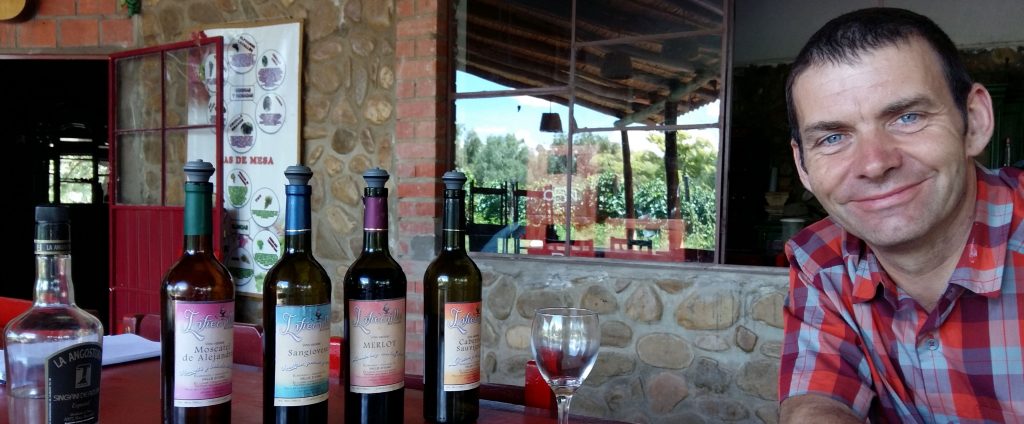
In our (rather loose) itinerary across south Bolivia we allocate 16th Jan as ‘Wine-tasting Sunday’ and head out to the main wine valley, Valle de Concepcion. In addition to the wines, another vineyard product of the region, popular with the locals, is the ‘fire-water’ known as Singani. It’s not dissimilar to the pisco produced in neighbouring Chile and Peru, but it’s probably a little more… err… ‘agricultural’, so we’ll leave that off our tasing circuit for today!
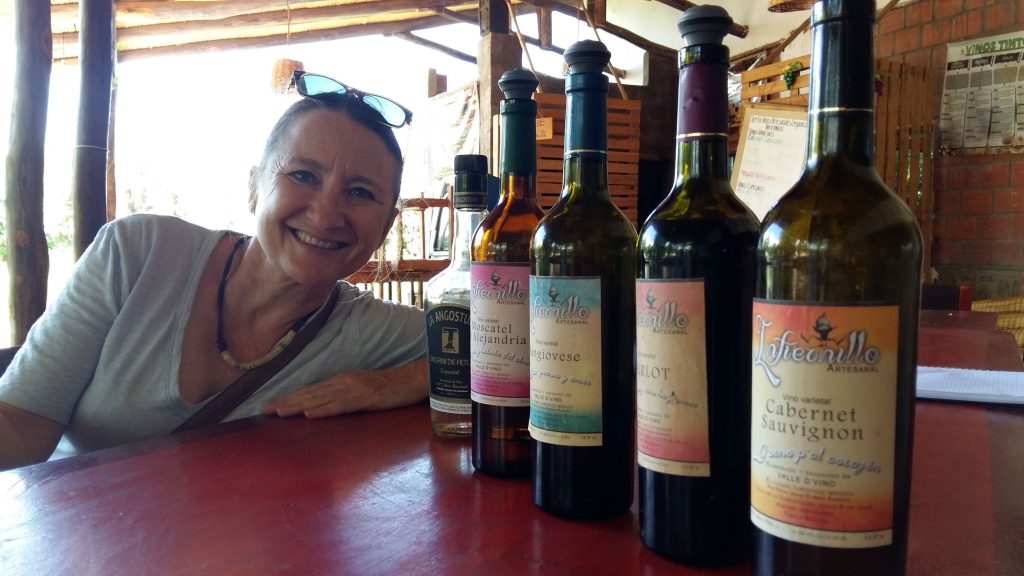 At winery No.1 Casa Vieja we test our first local ‘artesan’ wines… hmmm… rather sweet. And the ‘dry’ that we ask for is a bit… shall we say… ‘sharp’. Nevertheless, we have lovely traditional local Sunday lunch of roast suckling pig and move on to winery No.2 Casa de la Abuela’. Okay… so they seem to like their sweet reds ‘round here. Not exactly to our taste, they’re almost port-like in their syrupy sweetness, but they go down well with the locals who are drinking the stuff, literally, by the jug-load all through the afternoon. Not yet deterred (we can’t give up on ‘Wine Tasting Sunday’ that easily) we decide to give one more winery a try. Our Winery No.3 is Vino D’Valle where Daniel gives us a great tour of the vinyards, explaining in excellent English their processes and ethos of organic wine production. It’s an entertaining afternoon as we are joined by many locals enjoying a Sunday trip out of town. We really have no claim whatsoever to be wine-experts, but even we can spot the local penchant for the sweet. Very few of the regional wines are dry and those which they claim to be dry have a certain sharp ‘edge’ to them. It’s no surprise that Bolivia exports very little of it’s wine production, but for us it is an interesting and entertaining insight into yet another side of Bolivian culture. As a courtesy for the otherwise free tours and tastings, we buy a few bottles of the best plonk we can find. If we chill it well enough in the fridge, we’ll probably find an excuse to drink it at some point 🙂
At winery No.1 Casa Vieja we test our first local ‘artesan’ wines… hmmm… rather sweet. And the ‘dry’ that we ask for is a bit… shall we say… ‘sharp’. Nevertheless, we have lovely traditional local Sunday lunch of roast suckling pig and move on to winery No.2 Casa de la Abuela’. Okay… so they seem to like their sweet reds ‘round here. Not exactly to our taste, they’re almost port-like in their syrupy sweetness, but they go down well with the locals who are drinking the stuff, literally, by the jug-load all through the afternoon. Not yet deterred (we can’t give up on ‘Wine Tasting Sunday’ that easily) we decide to give one more winery a try. Our Winery No.3 is Vino D’Valle where Daniel gives us a great tour of the vinyards, explaining in excellent English their processes and ethos of organic wine production. It’s an entertaining afternoon as we are joined by many locals enjoying a Sunday trip out of town. We really have no claim whatsoever to be wine-experts, but even we can spot the local penchant for the sweet. Very few of the regional wines are dry and those which they claim to be dry have a certain sharp ‘edge’ to them. It’s no surprise that Bolivia exports very little of it’s wine production, but for us it is an interesting and entertaining insight into yet another side of Bolivian culture. As a courtesy for the otherwise free tours and tastings, we buy a few bottles of the best plonk we can find. If we chill it well enough in the fridge, we’ll probably find an excuse to drink it at some point 🙂
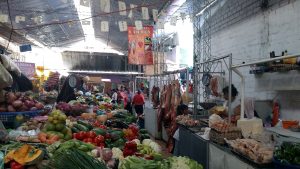
Tarija – top-notch market
Other than being the centre of the Bolivian wine region, Tarija is a pleasant city, home to the best steak-house in Bolivia and one of the best in the whole of South America. Anyone travelling up to Tarija from nearby Argentina will no doubt be rather blasé about decent steaks, however for carnivores like us who have travelled down from Ecuador, Peru and northern Bolivia (where, lets be honest, quality meat is not high on their list of many other fortes) the Rodeo steakhouse is truly special treat not to be missed.
Finally before leaving Tarija we have the mission of getting Cuthbert’s air-filter bracket welded. It hasn’t broken yet, but Marcus notices in his routine checks that the previous weld (from Iquique around 5 months ago) is starting to crack again. The rough roads from chasing the Dakar Rally and the last few days bouncing across southern Bolivia have taken their toll on this particular weak-spot. Luckily it’s not critical; it’s easy and cheap to fix with a friendly local welder.
Heading to the Chaco Heat
So we’re now pretty much done with Bolivia. Once we have driven the last 300 km east to the Paraguay border, there will be hardly a corner of Bolivia that we haven’t seen over our three visits here.
The first 150 km of the drive is across mountains to the eastern edge of the altiplano. At around 2,000m the altitude is high enough for a lovely summer climate (warm, sunny days with cool nights) but low enough that we aren’t suffering any wobbly-effects of altitude. The problem is that we know we are imminently heading for the HEAT. We know, that after descending from the mountains to the eastern plain at just 300m asl, the final 150km of Bolivia (and most of Paraguay) will be sweltering in its seasonal summer heat. It’s not an ideal travel plan, but we want to get down to Brazil and somehow we have to across the vast ‘El Chaco’ plain between here and there.
As we leave Tarija we work out that we can, in theory, make it in one day all the way across the mountains and down to El Chaco, but we decide to hang-back for just one more night. Like kids hovering on a swimming-pool high-board hesitant to plunge into the water, we sit for a night on the edge of the Bolivian altiplano, overlooking the drop down to the low ground below, knowing that when we descend in the morning we will find day-time temperatures way in excess of 40C and sometimes up to 50C. Having lived for years in Qatar where these temperatures are a feature of life for several months every year, we have a better idea than most of coping (or not) in this heat. So in our final hours of coolness in the mountains, we steel ourselves for the descent to the border and our long transit of El Chaco. We have great air-con in Cuthbert as we drive… so here goes! Watch this space for reports from Paraguay… and the HEAT!
Link to next blog: Paraguay Link to full South America Blog
Bolivia: Celebrities and Wine – Photo Gallery
- Tarija – top-notch market
- Uyuni Salt Pan – January-style
Click here for a few more pics at Bolivia Picture Gallery

